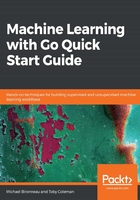
Unsupervised learning problems
Unsupervised learning problems aim to learn from data that has not been labeled. For example, given a dataset of market research data, a clustering algorithm can divide consumers into segments, saving time for marketing professionals. Given a dataset of medical scans, unsupervised classification algorithms can divide the image between different kinds of tissues for further analysis. One unsupervised learning approach known as dimensionality reduction works in conjunction with other algorithms, as a pre-processing step, to reduce the volume of data that another algorithm will have to be trained on, cutting down training times. We will cover unsupervised learning algorithms in more detail in Chapter 4, Unsupervised Learning.
Most ML algorithms can be efficiently implemented in a wide range of programming languages. While Python has been a favorite of data scientists for its ease of use and plethora of open source libraries, Go presents significant advantages for a developer creating a commercial ML application.